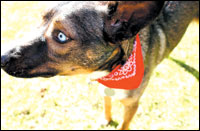|
Song
Dog Kennels
|
|
|
|
Home
of SONG DOG KENNELS -- Sole copyrighted Registry for the AMERICAN
INDIAN DOGS
|
| Ancient
Breed By Kyra Kirkwood, Correspondent for Pasedena Sun Times, published January 13, 2005 |
 Descended from coyotes and wild dogs, American Indian dogs are smart and seem part human and part cat. |
![]()
|
A breed of dog with a history stretching back
30,000 years is making a comeback, thanks to dedicated breeders
and passionate owners. |
|
|
"They actually are a thinking breed,"
Knight said. "They are alert. They miss nothing." These dogs are not wolf-hybrids or coyote mixes.
They are members of an historic breed with unique characteristics,
she said. |
|
|
Austin Vilardi, 9, of Riverside with Meeka |
Each dog is different
-- they are not bred to be carbon copies of each other nor a breed
ideal. Yet despite their beauty, physical attributes and marked intelligence, these dogs are not for everyone. "You have to be alpha all the time with them," Knight said, referring to the need for the humans to claim the boss role in the house. "They can own you easily if you don't continue to maintain your alpha position." While they may look like exotic wild animals, American Indian dogs are domesticated. They are good with people and children, and they love to play endlessly, especially with others in the breed. The melodious sounds they emit when playing are akin to the baying of a coyote. They're not vicious, but are often cautious around strangers. |
|
And, as Knight points out, they are definitely
not "outdoor only" dogs. Interviews are required. The wait for a puppy
is often long, and requesting a particular color only extends
the waiting period. |
Robert Gandrup of Aromas (Monterey County)with his dog, Tulip. |
"They can teach you as much as you teach them," Knight said. "There's something about these dogs that make the owners become very, very consumed with them." -- Kyra Kirkwood is an Orange County-based freelance writer. |
|
|
Karen Knight of Monrovia gives crispy rice treats to her dog, Waya, which means wolf in Cherokee |
-- As American Indian
Dogs are so rare, there are few respectable breeders across the
nation. Do your homework if you wish to get one. To make sure you
get a registered American Indian dog, ask for the breeder's number,
the litter number and check with the Registry for American Indian
Dogs before purchasing. |
